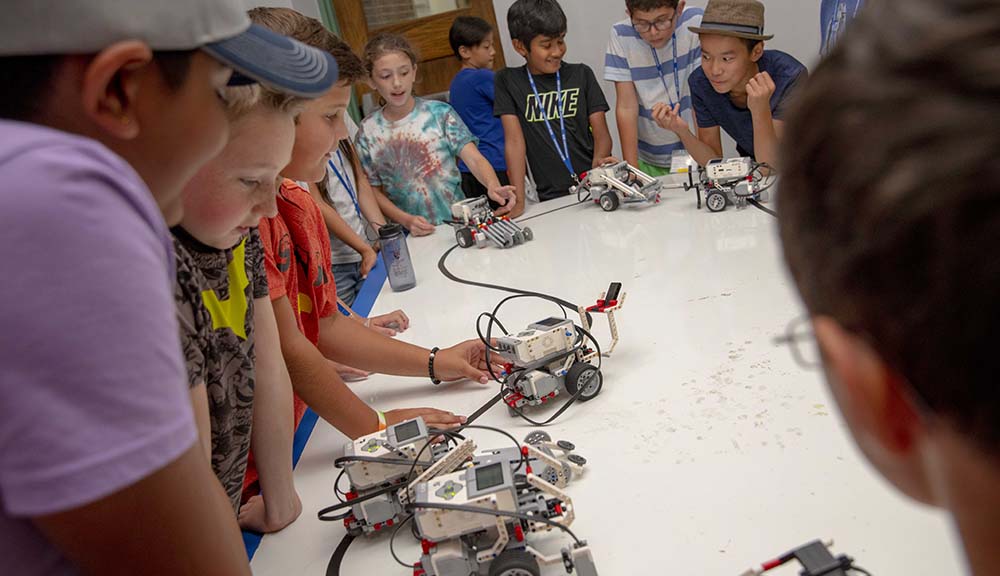The STEM Education Center started the program four years ago as a way to help schools meet Massachusetts’ Plan for Excellence in STEM Education, according to Mia Dubosarsky, director of professional development at the STEM Education Center. The Mass STEM Plan aims to enhance students’ interest and proficiency in STEM subjects, increase graduation rates, and support teachers as they become more effective STEM educators. The STEM Integration for District Leaders program, now entering its fifth year, is the only program of its kind in the state, to Dubosarsky’s knowledge. It consists of a summer opening institute, five academic-year sessions, and a culminating presentation at the end of the year.
“Everything we do here at the STEM Education Center supports STEM education in all aspects, not just this program. We really see ourselves sharing best practices in STEM and put a lot of time into research-based programs based on educators’ needs,” she says, adding that this focus “fits with WPI’s plan of theory and practice.”
The program focuses on guiding school and district leaders because of research that shows without their buy-in, “no reform can take place,” Dubosarsky says. Often, education leaders don’t come from the STEM disciplines or may not be aware of all the STEM programs and activities—or lack of them—in the classrooms, she adds. That’s why it’s also important that the team includes administrators, teachers, and school leaders from a variety of knowledge areas and age groups.
“The WPI approach of having me as an administrator and other teachers at different levels and in different disciplines coming together and sharing experiences, sharing the development of the plan, and sharing ownership of the plan, has really allowed us to cultivate lots of fruit because there was that level of ownership and engagement,” says Bernard (Bernie) Audette, principal of the Holy Name Central Catholic Jr. Sr. High School in Worcester. His school participated in Year II of the program.
In choosing participants, the Center strives for a balance of schools from different socioeconomic levels, educational models, and varying levels of STEM education preparedness.
“Teams come from different starting points and have different end goals,” Dubosarsky says, but having a balance allows them to share information and learn from each other.
Some schools are starting almost from scratch, others have programs in place, but we want to make sure they continue to meet the state’s most current standards. Dubosarsky says Cambridge Public Schools, a large district that participates in the current year, wanted to conceive a plan that was general enough to apply to a big district but also allow each school to keep its uniqueness. Two much smaller Montessori schools who have finished the program wanted to work STEM into the traditional Montessori curriculum.
The selected teams start by discussing the definition of STEM (or STEAM, which includes an arts or humanities component) and what it means to each of their communities. They also assess existing STEM programs in their schools, and are often surprised to learn they have more in place than they thought.
“Just the fact that they are sending their colleagues into the schools to ask teachers what they’re doing with STEM, they find programs they didn’t know were happening,” says Dubosarsky. Team members also discover that some school activities, such as field trips, can become STEM-rich just by making small adjustments.
The Center encourages the teams to think not just about what they can do to boost STEM education now, but where they want to be in five years. What will the classrooms look like? What will the teachers and students be doing?
“We ask them to start to dream, and that’s hard,” says Dubosarsky, especially for schools that have little or no funding for STEM programs. The Center encourages all teams to reach out to local businesses, parents, and community leaders and see what STEM resources are out there. Often major companies will lend support through materials, volunteers, or funding, she says, “But even a network of parents who work in the STEM fields bringing students to work for job shadowing can be a big help.”
At mid-year, the STEM Integration for District Leaders program shifts focus from planning outcomes to developing action steps based on needs and resources.
“You can’t do everything, so we help the teams create a framework of what’s most important, what needs to be developed, and what existing programs can be adapted to meet their needs,” says Dubosarsky.
“Making the whole logistics chart took a lot of time, and was a challenge,” says Amanda Martinez, who was on the Thomas Prince School team (Wachusett School District) from Year II. “However, it was necessary and eye opening to see where we need things, what’s already happening, and what needs to happen. It was extremely helpful, and I got a full view of where we’re at as a school. I think I was very lucky to be on the team to see that.”
The selected teams start by discussing the definition of STEM and what it means to each of their communities.
Registration for the program costs just under $4,000. Dubosarsky says EMC Corp. has provided support to the program in past years and some teams have been able to secure a grant before attending. “Other schools have found that participating in the program is very helpful in getting a grant” in the future, she adds, noting that one of the program’s sessions focuses on funding resources.
Looking back two years from when his school participated in the program, Audette says he sees a significant improvement in STEM education there.
“I do believe that a lot of that [STEM integration in school] has to do with work we did as part of the STEM Integration program,” he says. “First and foremost, because it helped us identify specific things. It helped us understand and articulate for ourselves, for our advisory board, for the faculty why that was important and why we were going to continue to move in that direction. So that has been, I think, extremely positive.”
Participating in the program has also helped his school’s teachers set and achieve goals in other areas of the curriculum, he says. “The process of analyzing, identifying what you want, developing a strong plan to get there, identifying all of the different activities, identifying your obstacles—it’s clearly more of a systematic thinking approach that has really, really helped [the teachers] who had that experience. I would not know how to quantify it in any other way than to say I see it all the time. That’s a new behavior.”
The program evaluator, Jeanne Hubelbank, collects, analyzes, and reports formative and summative data to improve the program from year to year. Hubelbank is currently in the process of evaluating the long-term effect of the program.
The STEM Education Center is currently accepting applications for the 5th year of the STEM Integration for District Leaders program.



